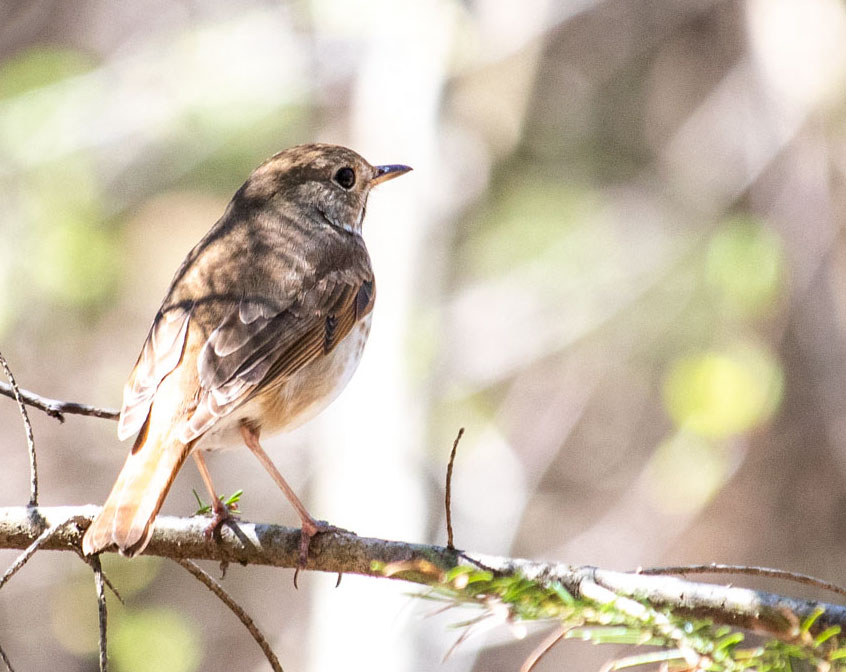
Although the hermit thrush doesn’t migrate very far for the winter, I usually don’t see them here in our woods until the early part of spring. I will spot them hopping around on the ground while we still have a small amount of snow on the ground, searching for food, or beginning to sing in order to attract future mates. They will make themselves known to me just for a short moment out of curiosity, only to disappear again and go about their business. On a few occasions, while walking out in the woods, I had the pleasure of just a few sightings of a breeding pair during the early part of this May.
On one particular morning, I spotted these two hermit thrushes in another location out in the woods and the most interesting thing occurred. One of the hermit thrushes flew off and watched me from its perch, sort of scolding me from afar while raising its tail and wiggling its wings. The other stayed back and seemed to be a bit more curious about me. The bird then went ahead and struck a few different poses for me on the ground and then proceeded to perch on a nearby branch. I had my camera with me, of course, and I then started to click away. I then decided I was finished photographing the hermit thrush and left the pair so we could all get on with the rest of our day.
I was quite thankful for my chance encounter with my photogenic hermit thrush. I haven’t seen the breeding pair since and now that we are moving into the summer months, I believe they are back to practicing their private behavior during the nesting season. Recently, I have been making sure to keep to the trails in the woods, being careful not to step on one of their nests, as these birds share the same ground-nesting activities as several of our other ground-nesting bird species here in Maine. Perhaps, I will have the opportunity to see their offspring in the coming weeks.
I would like to share a few interesting facts about the hermit thrush Catharus guttatus as well as a few photographs of this secretive bird.
Hermit Thrush Size & Description
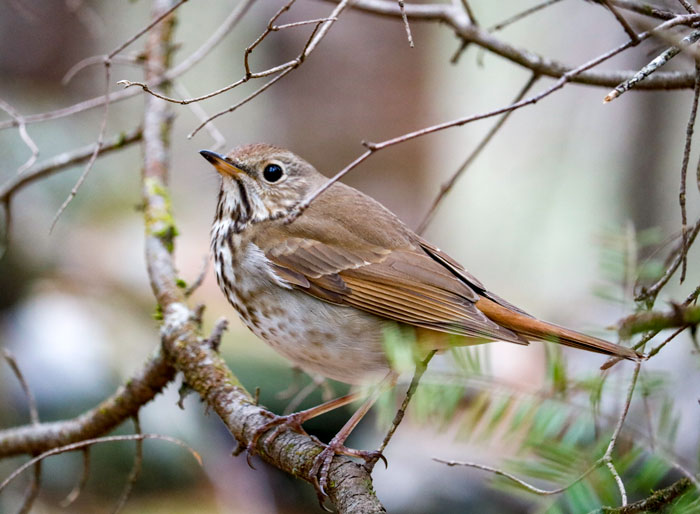
The hermit thrush’s stocky shape is similar to that of the American robin, but a bit more compact. They stand upright and have a slender, straight bill that is slightly raised. Similar to other thrushes, their heads are round and the tail is fairly long.
These birds have a rich brown color on the head and back, with a distinctly warm, reddish tail. Underparts are pale with distinct spots on the throat and smudged spots on the breast as well as grey or brownish flanks. They have pink legs and a white eye-ring.
Hermit Thrush Habitat
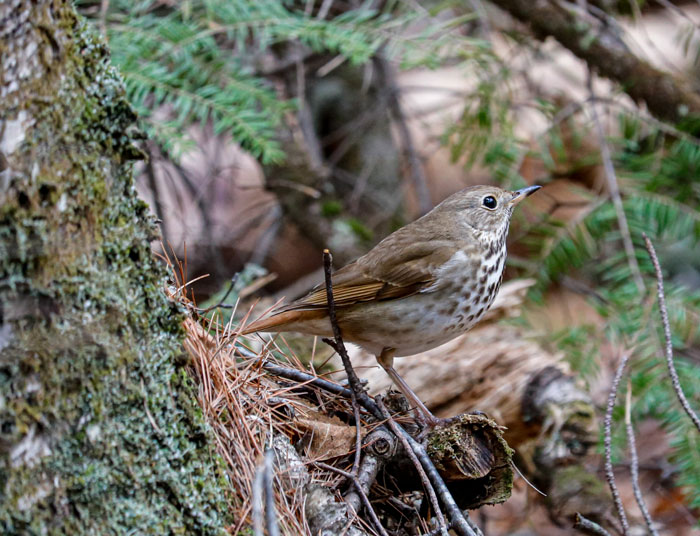
You can find hermit thrushes in the understories of the forest, especially around the edges or openings. These birds prefer conifer or mixed woods, forest floor. During the winter, they prefer woods, thickets, and parks. Breeding habitats will vary in different regions; including spruce woods, sphagnum bogs, dry pine woods, second growth in burns with standing dead trees, thickly wooded canyons, mountain forests of spruce, and fir. During migration and the winter, hermit thrushes can be found in any kind of woodland.
Hermit Thrush Behavior
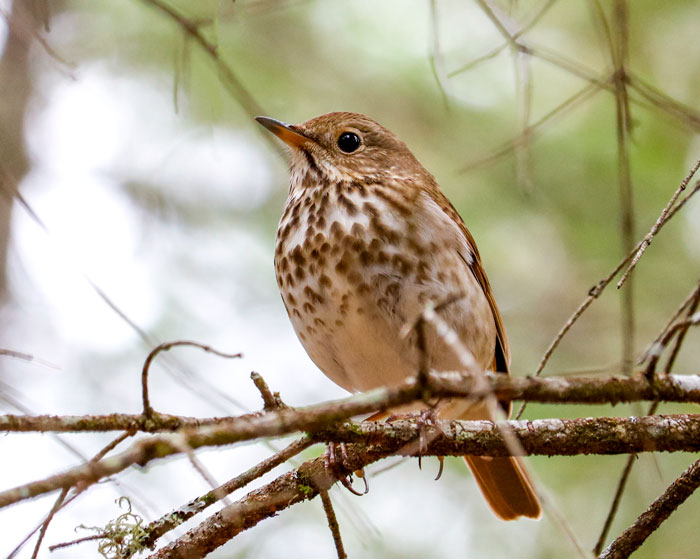
Hermit thrushes forage on the forest floor and will often hop and then stay still, peering at the ground. They also forage in trees or shrubs, mainly eating insects and berries. They sometimes pick up leaf litter with their bills or shake grass with their feet in order to find insects. When they are about to fly, they flick their wings or tails. These birds may respond to predators by crouching and pulling back its head. During the winter, you can find the hermit foraging with other songbirds such as kinglets, chickadees, titmice, and brown creepers.
Hermit Thrush Diet
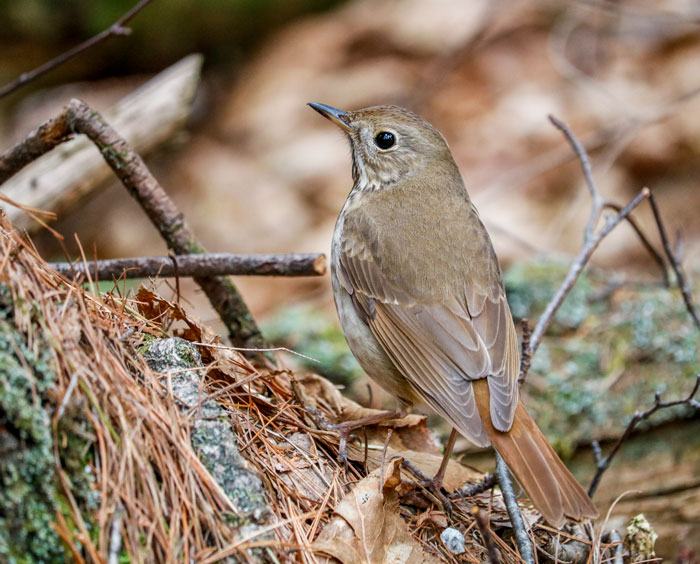
During the spring, the hermit thrush eats mainly insects such as beetles, caterpillars, bees, ants, wasps, flies, true bugs, grasshoppers, crickets, and many others; also spiders, earthworms, as well as many others. They will also occasionally eat small amphibians and reptiles. In the winter, they change their diet to eat more fruit, including wild berries such as elderberries, pokeberries, serviceberries, grapes, mistletoe berries, and many others.
Hermit Thrush Song & Call
While out in the woods, one of my favorite songs to hear is that of the hermit thrush. This beautiful and ethereal melody can be described as both flute-like and haunting. Its song begins with a sustained whistle and ends with softer, echo-like tones, described as oh, holy holy, ah, purity purity eeh, sweetly sweetly. It pauses between each phrase, and the song is about one and a half seconds long. These birds also deliver an extremely faint “whisper song” during the spring.
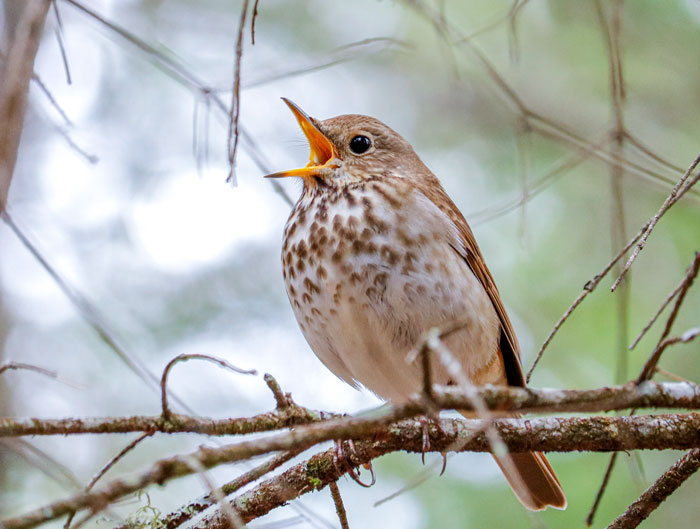
The most frequently heard call of the hermit thrush is a low-pitched tchup or quoit to signal attack or escape and a cedar waxwing-like eeee when in danger. Adults may tell their young to stay still with a two-syllable chuck and lisp.
During territorial displays, hermit thrushes may snap their bills loudly or make a whistling sound with their wings while in flight. Their feet can produce rattlesnake-like sounds as they scratch in vegetation for food.
Hermit Thrush Breeding & Nesting Behavior
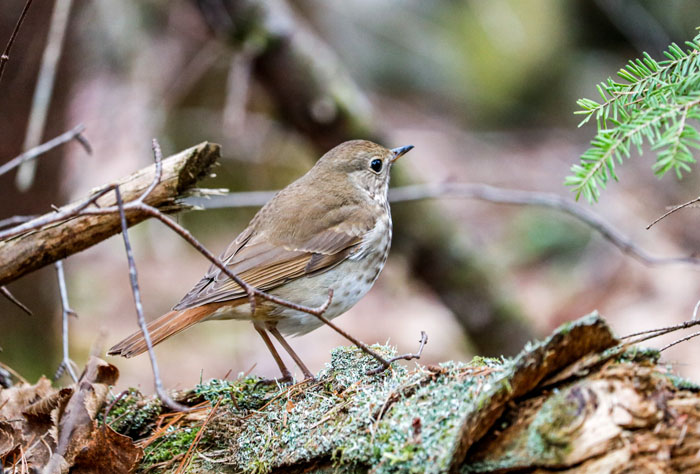
The males defend their nesting territory by singing, especially in the mornings and evenings. In the east and north, nesting sites are often on the ground, in a natural hollow on the side of a hummock, and well hidden by overhanging branches or surrounding low vegetation. In the west, nests are usually constructed in trees, especially conifers, three to twelve feet above the ground.
Nests are built by the females and they are bulky, well-made open cups of moss, weeds, twigs, bark strips, and ferns, lined with softer materials such as pine needles, rootlets, and plant fibers.
There are four eggs, sometimes three to five, rarely six. Eggs are a pale blue or greenish-blue color, occasionally flecked with brown or black. Incubation is done by females for about twelve days. Both parents feed nestlings. The young are ready to fly at about twelve days. These birds have usually one to two broods per year, perhaps sometimes three in the south.
Hermit Thrush Migration

The hermit thrush is a short-distance migrant. These thrushes are the first to head north in spring and the only ones to winter in the United States.
How to Attract the Hermit Thrush to Your Yard
Hermit thrushes rarely visit backyards and in general, will not visit feeders. Although, during migration, they often forage on the ground or eat berries in yards filled with a variety of trees or shrubs. In order to attract hermit thrushes to your yard, you can provide an abundance of food sources such as berry bushes. One such example is that of the Toyon, a large perennial evergreen shrub that provides these birds with nutritious red berries. This bush provides leaf litter and cover for hermit thrushes as well.
Over the past year, I have planted several varieties of berry bushes around the house as well as on the edge of the woods in the backyard and I’m hoping to attract more of these birds as well as many new species of birds. In the future, I can’t wait for these berry bushes to thrive and to see what kind of visitors I will get to observe in the yard.
Thank you for reading.
Resources used for this post:
allaboutbirds.org & audubon.org
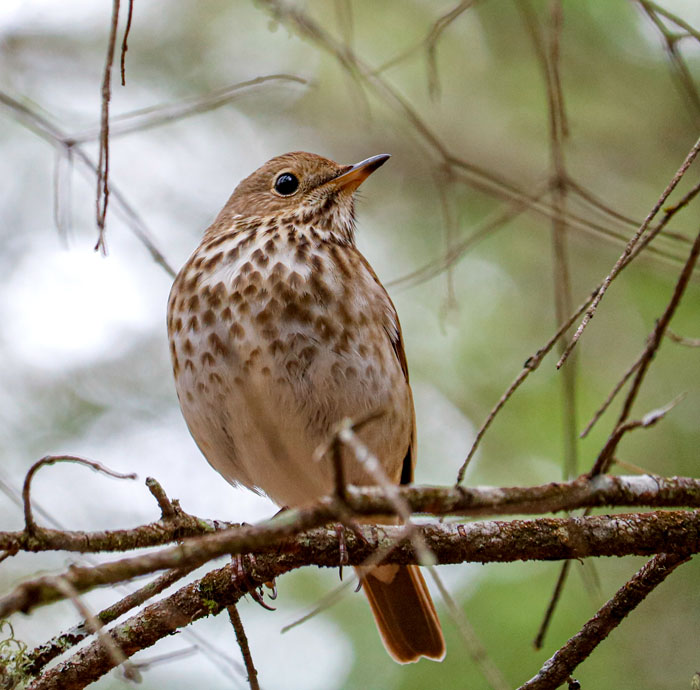
Thank you for a detailed and concise posting. I have seen a hermit thrush visit our garden in Santa Rosa CA now (October) and in late winter among some shrubs and potted plants. I have read and heard that the red berries of Heavenly Bamboo are poisonous to birds and it’s recommended to prune them off. Can you speak to this?
Hello Lesli, I’m glad you liked the post and thank you for reading! I’m so glad you had the chance to see one of these lovely birds! In regard to your question, I believe although heavenly bamboo is aesthetically pleasing to look at, it is in fact poisonous to birds. The berries contain cyanide and can be toxic. This is especially true for migratory birds that will gorge themselves on these berries. These plants can also be quite invasive and propagate from the seeds of fallen berries, so pruning them would be a good idea. I hope I have answered your question and please let me know if you have any more! Take care, Laura